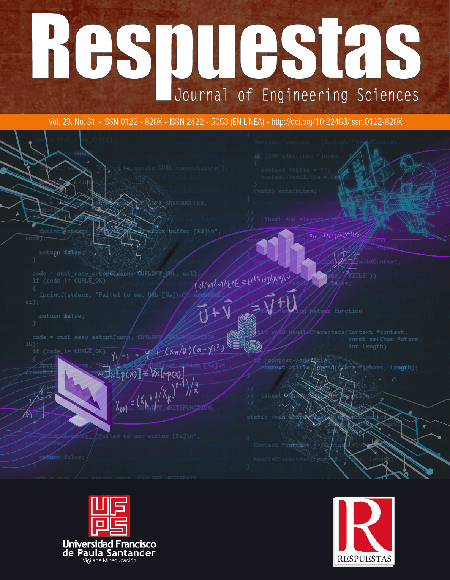Analysis of vitamin B2 in white rice commercialized in the Metropolitan Area of Cúcuta by ultra-fast liquid chromatography (UFLC)
Análisis de vitamina B2 en arroz blanco comercializado en el Área Metropolitana de Cúcuta por cromatografía líquida ultra rápida (UFLC)
Main Article Content
Background: Riboflavin analysis is one of the parameters most referenced in the determination of the nutritional value of some
foods. Objective: standardize the method of analysis and determine the content of riboflavin (vitamin B2) in samples of white
rice fortified (A and B) and unfortified (C and D), marketed in the metropolitan area of Cúcuta. Method: the extraction and
triplicate analysis of two batches of each sample was performed. Unfortified samples were doped in order to determine the
percent recovery of the method. Three samples of 5,0000 grams of each batch of fortified and non-fortified rice, were subjected
to the extraction process of the vitamin by acid hydrolysis, after enzymatic treatment with papain and takadiastase at 45 ° C. The
extracts were purified by filtering with filter paper, and again by regenerated cellulose syringe filters of 0.20 μm. The riboflavin
concentration in each extract was determined in triplicate by HPLC on a UFLC SHIMADZU Prominence liquid chromatograph.
The statistical analysis of data was carried out with the software R version 3.2.2. Results: the average concentrations, in mg
riboflavin / kg of rice, in rice samples A, B, C and D were 0,4121, 2,3741, 0,3208 and 0,3217, respectively for batch 1, and for
batch 2 were 2,3831, 1,0552, 0,4022 and 0,3246, respectively. Recovery percentages of riboflavin in doped samples were about
91.00%. Conclusion: it is noted that between different batches of fortified rice of the same brand there is variation in the content
of vitamin. In samples of not fortified rice, the concentration found corresponds to the natural riboflavin content in rice, with
similar values in all samples.
Keywords: Cereals,Fluorescence,HPLC,Riboflavin,Vitamins
Downloads
Article Details
M.E. Calles Porcel, “Estudio de un proceso de control analítico cuantitativo para la determinación de vitaminas hidrosolubles (tiamina, niacina, ácido fólico, riboflavina) por cromatografía liquida de alta eficiencia en harinas de trigo fortificadas”. trabajo de fin de grado, Universidad de Guayaquil Facultad de Ciencias Químicas, Ecuador. 2004.
J.F. Gregory III, Vitaminas. En: Química de los Alimentos. 2nd. ed. España. Acribia (Ed.). 2000.
B.A. Fox y A.G. Cameron, Ciencia de los alimentos, nutrición y salud / B.A. Fox, A.G. Cameron, 2002.
M.A. Royo Bordonada, coordinador, Nutrición en salud pública, Instituto de Salud Carlos III, Ministerio de Sanidad y Consumo, Madrid, 2007.
N. Chen, S. Yin, X. Song, L. Fan & H. Hu, “Vitamin B2 Sensitizes Cancer Cells to Vitamin-C-Induced Cell Death via Modulation of Akt and Bad Phosphorylation”, Journal of agricultural and food chemistry, vol. 63, no.30, pp. 6739-6748, 2015.
Organismo Andino de Salud, UNICEF. (2011, mayo). Respuestas de Salud y Nutrición Infantil Frente a la Crisis Económica en la Región Andina (1st ed.). [Online]. Disponible en: http://www.orasconhu.org/sites/default/files/files/LI-BRO%20RESPUESTAS%20DE%20SALUD%20Y%20NUTRICION%20INFANTIL.pdf [Accedido en: nov. 10 de 2017]
H. Pachón, “Fortificación del grano de arroz”. Ministerio de Salud y Protección Social, Bogotá, Inf. téc. 2013.
F. Tello Saavedra. et. al., “Estudio de pre-factibilidad para la instalación de una planta para obtener bioetanol a partir de residuos lignocelulósicos-cáscaras de arroz (Oriza sativa) en la Región Loreto”. trabajo de fin de grado, Universidad Nacional de Amazonia Peruana, Perú. 2014.
A. Gliszczynska-swiglo, A. Koziolowa, “Chromatographic determination of riboflavin and its derivatives in food”, Journal of Chromatography, vol. 881, no. 1, pp 285-297, 2000.
X. Tang, D. A. Cronin, and N. P. Brunton, "A simplified approach to the determination of thiamine and riboflavin in meats using reverse phase HPLC," Journal of Food Composi-tion and Analysis, vol. 19, pp. 831-837, 2006.
T. Fernández-Cárdenas, H. González-San Miguel, y L. Travieso, Determinación de vitaminas del Complejo B en Arthrospira máxima por cromatografía líquida de alta resolución vol. 42, 2017.
L. A. Calderón Sánchez, O. Pazmiño Sánchez de Sayago, “Estudio comparativo de las ventajas de la HPLC en relación con la Fluorometría en la determinación de vitaminas B1 y B2 en jarabes infantiles”, Tesis Ph. D. Universidad de Guayaquil Facultad de Ciencias Químicas, Ecuador. 2004.
L. Gil, et. al., “Evaluación del contenido de riboflavina por método de cromatografía líquida de alta resolución (HPLC) en harinas de lenteja (Lens e)”, Alimentos Hoy, Revista de la Asociación Colombiana de Ciencia y Tecnología de Alimentos,vol. 22, no. 32, pp. 16 - 24, 2014.
C. Bueno-Solano, et al., “Cuantificación de riboflavina (vitamina B2) en productos lácteos por HPLC”, Revista Chile-na de Nutrición, vol. 36, no. 2, pp. 136-142, 2009.
M. G. Mencos De León. “Evaluación de dos métodos; cromatografía líquida de alta resolución (HPLC) y cromatogra-fía líquida de ultra rendimiento (UPLC); para la cuantificación simultánea de cuatro vitaminas hidrosolubles en harina de trigo”. Tesis. Facultad ciencias Químicas y Farmacia, Universi-dad de San Carlos de Guatemala. Guatemala. 2011.
P. Wang, Y. Yin, S. A. Eremin, V. B. Rybakov, T. Zhang, Z. Xu, et al., "Indirect Competitive Immunoassay for Detection of Vitamin B2 in Foods and Pharmaceuticals," Journal of Agricultural and Food Chemistry, vol. 61, pp. 7048-7054, 2013.
R Core Team. “R: A language and environment for statis-tical Computing”. R Foundation for Statistical Computing. Vienna, Austria. Noviembre 2015. [Online]. Disponible en: https://www.R-project.org/ [Accessed: Jul-23-2018].
Instituto de Salud Pública, “Determinación de riboflavina (vitamina B2) en harina de trigo. Método fluorométrico – HPLC Basado en método 970.65 AOAC”, Ministerio de Salud - Gobierno de Chile, doc. tec. Versión 7. mayo 2016.
J. C. Miller y J. N. Miller, Estadística para Química Analí-tica. 2nd. ed. Washington. Addison-Wesley Iberoamericana S. A. 1993.







